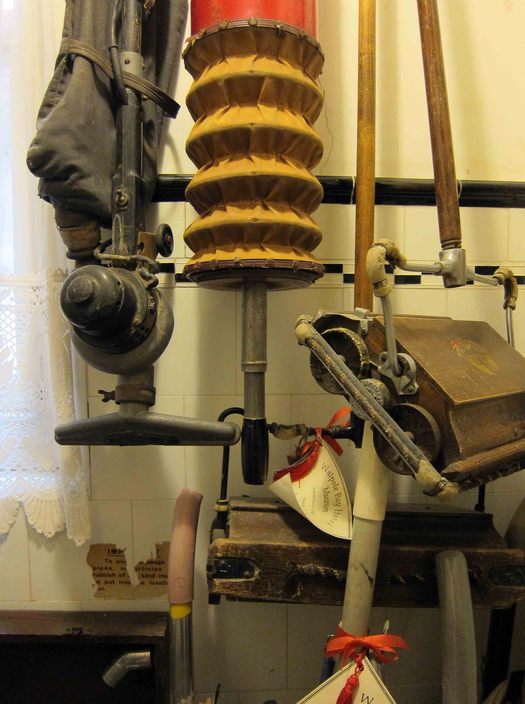
A cupboard display exploring “Cleaning through the ages” at the Walpole Bay Hotel, Cliftonville, near Margate, UK
At the weekend I visited Margate on the English coast to see an exhibition with the irresistible title “Curiosity: Art and the Pleasures of Knowing” at Turner Contemporary, an ambitious gallery by the sea, which opened in 2011. I hadn’t been to Margate since a brief visit 30 years ago and a return seemed long overdue. The Rough Guides travel book empire dubbed the town one of its “top ten places to visit in 2013” alongside more obvious contenders such as Puerto Rico, Dubrovnik, and Stockholm. After a quick check online of available hotels I made a reservation at a place overlooking the sea in nearby Cliftonville called the Walpole Bay Hotel. It sounded eccentric and I was intrigued by the hotel’s claim also to be a museum, with a collection of artifacts, which I vaguely imagined to be housed in some adjoining rooms.
What I didn’t know when I booked is that in 2009 the Walpole Bay Hotel was a featured case study in a TV series titled The Hotel Inspector, where a hotel expert, Alex Polizzi, attempts to “salvage some of Britain’s worst-run” establishments. I have never watched The Hotel Inspector and that’s why I had also been unaware that Polizzi’s return to the Walpole in 2012 — following the pattern of these “inspector” shows — was broadcast again last week. Discovering this on the eve of departure wasn’t a good omen, but why spoil the fun by watching the program (which was available online) before the visit? And anyway, the museum sounded intriguing. The whole point of the trip, with “Curiosity” as its focal point and a visit to Margate’s mysterious Shell Grotto also planned, was a weekend of strange discovery.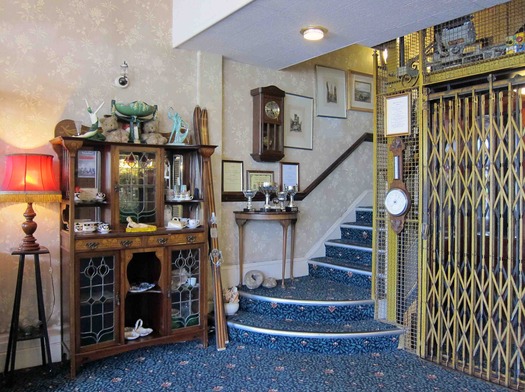 Lobby of the Walpole Bay Hotel, August 2013
Lobby of the Walpole Bay Hotel, August 2013
It became instantly apparent on crossing the threshold that the “Living Museum,” as the proprietor Jane Bishop likes to call it, is right there in the hotel. The lobby, seen in the picture above, is awash with bric-a-brac flowing across every available surface. Shelves laden with tea cups, toys, drinking glasses, vases, figurines, old cameras, costume jewellery, and musty books give rise to an ambience more like a junk shop than a hotel or a museum. Occasionally, a curling printed label attached by a red ribbon indicates an object of note, such as an Art Nouveau cabinet, but the display principle that requires two teddy bears to be jammed between the ornaments on top is no more obvious than the curatorial thinking that led a pair of skis to be propped next to the cabinet at the foot of the stairs opposite the ancient gated elevator for which (a sign says) the hotel accepts no responsibility.
A brochure promises that the Living Museum will “eventually engulf the entire hotel” — a choice of words, suggesting suffocation and collapse, that sounds much crazier than the copywriter intended, although the place is by any measure spectacularly weird. For now, the collection is mostly concentrated on the second floor (or third, for American readers). The first, where we stayed, is given over to a display of framed linen napkins decorated and inscribed by contented guests; the hotel has many admirers, including celebrities, and the artist Tracey Emin, who famously grew up in Margate, launched her book Strangeland there. Upstairs, the narrow, creaking corridors are obstacle courses of clutter: the exhibits include a stand bearing an array of cheese dishes decorated with floral patterns; old grocery tins of spices, baking powder and dried milk; photographs and documents in gilded frames; a headless mannequin clad in a nurse’s uniform; a row of empty milk bottles printed with advertising; a hornets’ nest; a telephone without a receiver; and a conclave of dolls and soft toys behind a balustrade in a penned-off area at the end of the landing.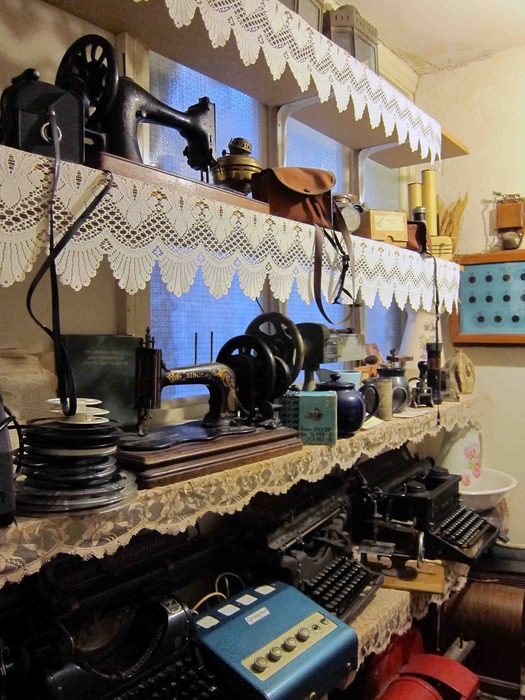 A room displaying “Typewriters through the ages” and other artifacts at the Walpole Bay Hotel
A room displaying “Typewriters through the ages” and other artifacts at the Walpole Bay Hotel
The hotel’s most curious tableaux are housed in small chambers — once cupboards, bathrooms and sculleries — located between the bedrooms. The signs on the doors convey a murkily defined educational purpose: “Cleaning through the ages,” “Kitchenalia through the ages,” “Typewriters through the ages” (the last two themes collide in the same room). The contents of these cubbyholes can be seen in the photographs here. For the most part, the “displays” appear to be largely haphazard, any attempt to portray the social history of the hotel in an earlier era being defeated by the prevailing imperative of clutter. The “Original 1914 maids [sic] scullery,” far from proving to be an example of meticulous preservation, looks more like the shameful spare room in a house where everyone deposits their unwanted items before finally attempting to dispose of them in a charity shop, flea market or yard sale.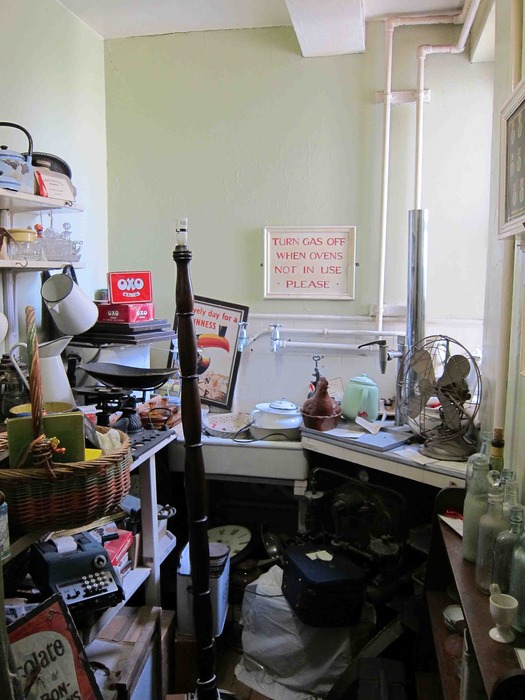
The “Original 1914 maids scullery”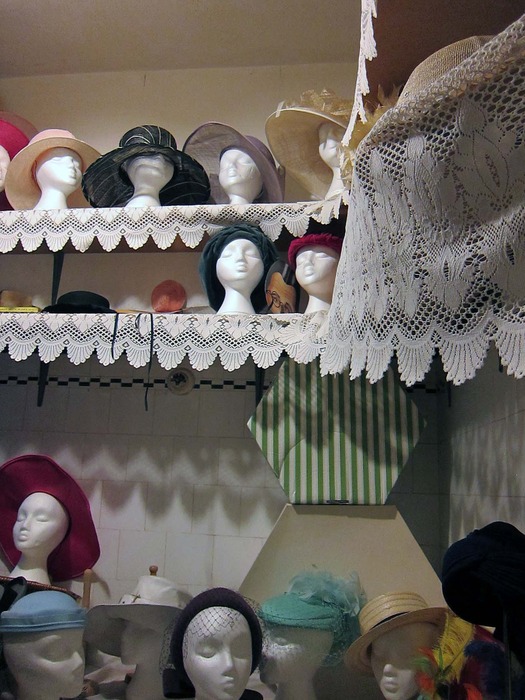
A closet full of hats, previously on display in the hotel lobby
I have to say I relished all of this. Our curiosity had been amply rewarded. We wanted strangeness and we had found it. If the hotelier’s goal had been to construct a private Wunderkammer using the Surrealist precept that beauty lies in the chance encounter between incompatible objects in unexpected situations, then the Walpole Bay Hotel could be seen as a magnificently relentless, if not deranged, realization of that principle. Yet, whatever the motivation, the displays could still be so much better. Whether the aim is historical explanation or art experience, the raw material cries out to be organized by someone with a clearer sense of purpose and a much more discerning and selective eye. If only a team of students doing masters degrees in curating could treat the Walpole as an installation project, they might be able to work wonders, though some of the junk would undoubtedly need to go.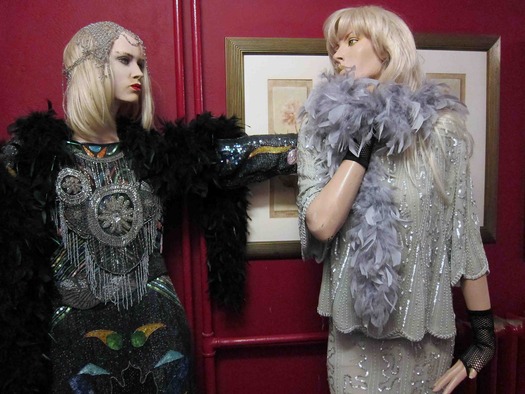 Mannequins in costume convene in the corridor
Mannequins in costume convene in the corridor
Photographs: Rick Poynor
For more on objects, see also:
The Strange Afterlife of Common Objects
The Never-ending Struggle against Clutter
Lost Inside the Collector’s Cabinet
The Irresistible Attraction of Self Storage

